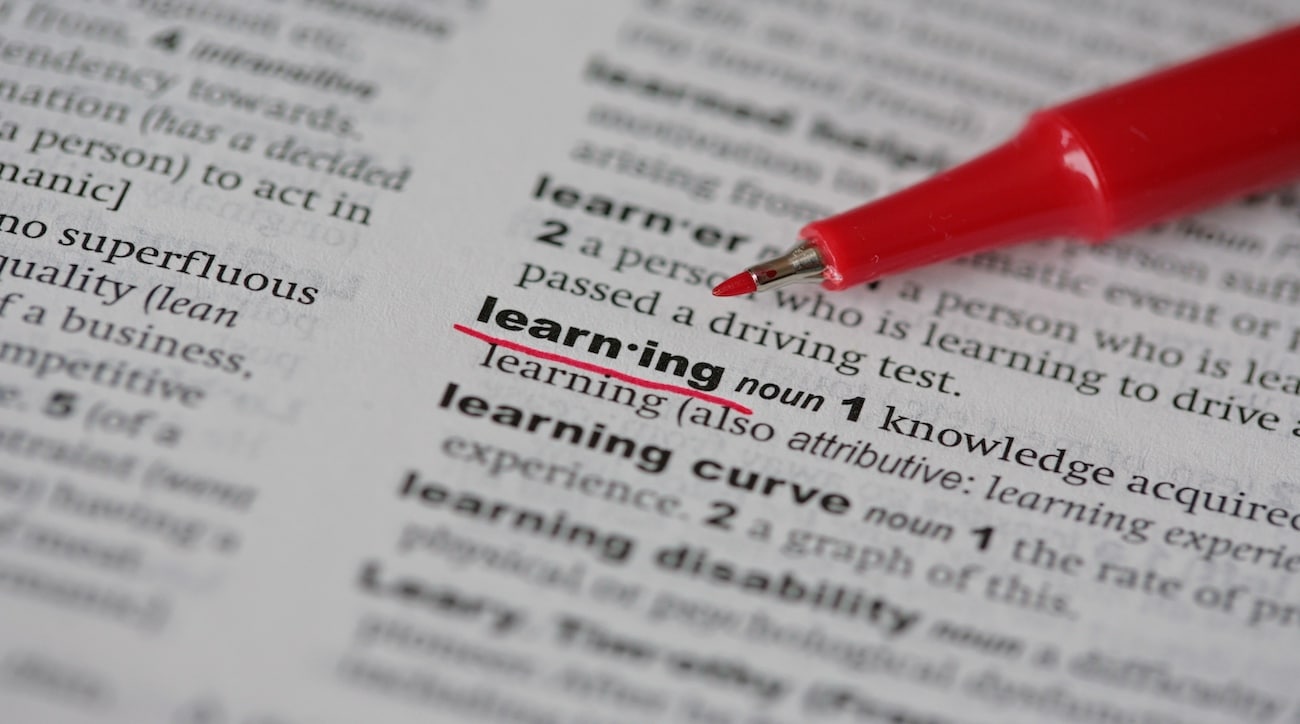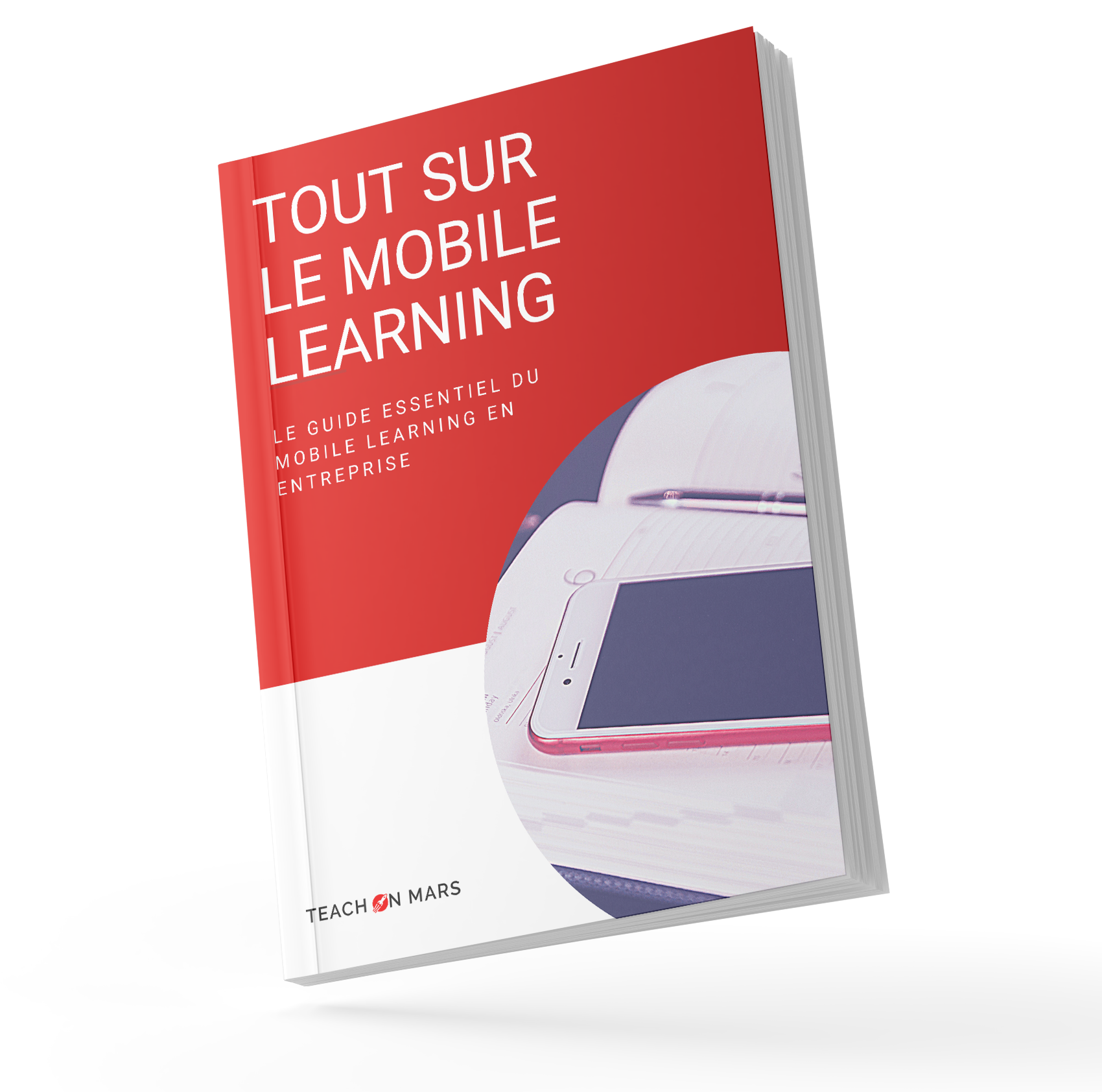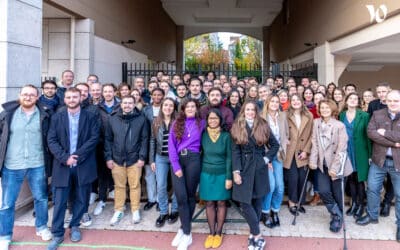Mobile learning, blended learning, gamification…all of these terms can sometimes sound a bit odd to newcomers to the world of digital learning. Here at Teach on Mars this is our everyday lingo, and we’d like to share it with you in a glossary containing all the key terms you’ll need to become a real Martian or Digital Learning Master!
A
Adaptive learning:
Adaptive learning is a methodology that strives to personalise courses, utilising a large amount of data to enable learners to progress.
Add-on:
An add-on is a module added to an application to provide new features.
Asynchronous:
We describe a course as asynchronous when learners participate at different times. Learners study according to their own schedule, at their own pace and without real-time interactions with the teacher.
ATAWAD:
ATAWAD (Any Time, Any Where, Any Device). This acronym is used to describe flexible learning which can be done anywhere and anytime.
ATAWADAC:
This is a more complete version of ATAWAD, with the addition of AC which stand for Any Content, and which places an onus on the diversity of available content, accessible anywhere and anytime.
Augmented reality:
Augmented reality is the incorporation of virtual elements into physical world videos made using a digital device (a telephone for example).
Authoring tools:
Authoring tools enable trainers to come up with and create e-learning content for students. The training content can thus be designed and disseminated.
B
Blended learning:
This is a kind of hybrid learning, combining e-learning and in-person instruction. A blended approach offers learners a comprehensive and multimodal training course.
Business Intelligence (BI):
Business intelligence is a decision-making technology utilising digital tools to collect data in order to help companies enhance their performance.
BYOD:
Bring Your Own Device (BYOD) is a policy that allows employees in an organisation to use their own devices, (PC, telephone, tablet computer) for work-related activities. This setup reduces costs for companies, while employees are able to use devices they are familiar with.
C
Collaborative learning:
Collaborative learning is an educational approach based on a community, in which every member of an organisation passes on their knowledge and skills to others. Collaborative learning is closely related to social learning and peer-learning.
COOC:
Corporate Open Online Courses (COOCs), are online courses provided for professionals and therefore by companies, unlike MOOCs which are open to all.
D
Deep learning:
A subset of Artificial Intelligence (AI), this Machine Learning technique teaches a computer to learn automatically in a highly accurate manner, using a more complex information network and inspired by neural networks.
Digital Escape Game:
Digital escape games are based on the same principle as classic escape games. They offer a means of exploring a scenario to discover objects, links and codes or a series of enigmas to reach a defined objective (to unlock content, find treasure, etc.). Digital Escape Games are increasingly used to gamify learning or to raise awareness about a specific subject.
Digital learning:
Digital learning is a 21st century instructional practice using digital developments to offer more efficient and enriching learning experiences for students. The definition encompasses both e-learning and in-person instruction, relying on digital tools (computer, telephone, etc.).
Distance:
Distance learning is in contrast to classroom learning, which, by definition, means being present in a given location. Distance learning enables users to engage in activity remotely (work, courses, etc.) The term is increasingly used since the advent of teleworking.
E
E-learning:
E-learning (short for electronic learning) refers to digital instruction. E-learning is largely synonymous with distance learning.
ELPA:
An acronym coined by Jérôme Wargnier, as he sought to define the keys to optimal mobile learning training. The ELPA model comprises 4 phases: Engage, Learn, Practice, Apply. To find out more about this topic, click here.
G
Gamification:
Gamification is the use of video game or mobile game mechanics to create an engaging and challenging user experience. Gamification is a pillar of modern learning.
H
Hard skills:
Hard skills refer to technical skills, such as command of a foreign language or software. This know-how focuses on the employee’s activity rather than on their way of interacting and working with others.
I
Immersive learning:
Using virtual reality, learners can be placed in a 100% virtual environment. Developments in Immersive Learning are highly anticipated and provide an insight into possibilities concerning roleplay activities.
In-class learning:
In-class learning, as opposed to distance learning, means physically attending a course or an event.
K
KPI:
Key Performance Indicators (KPIs) are implemented by each organisation in their various departments in order to gauge the performance of accomplished actions, with the aim of improving or modifying them.
L
LCMS:
The Learning Content Management System (LCMS) is a digital training platform that allows administrators to create content to contribute to online courses.
Learning company:
A learning company is an organisation which engages in a process of management and HR practices which aim to further develop learning within the company. This culture of learning enables organisations to improve their economic and social performance.
LEP:
The definition of the Learning Engagement Platform (LEP) is similar to that of the LMS and LXP; while placing a greater onus on user engagement.
LMS:
A Learning Management System (LMS) is a digital training platform deployed by employers and aimed at learners.
LXP:
The learning experience platform is an AI-driven platform which offers learners a more learner-centric experience than the LMS.
M
Metaverse:
A metaverse is a parallel universe, or a fictitious, virtual world. The metaverse can be accessed using virtual reality (VR) and opens up training possibilities, in particular as regards putting learned concepts into practice.
Micro learning/Microlearning:
Micro learning delivers content in short, specific bursts to facilitate learning. Engagement in this type of training is therefore greater as it does not require much time or concentration from learners.
Mobile learning:
Mobile learning is a type of digital learning designed with mobile phones and tablet computers in mind. It can also be accessed via laptop computers, but it is mobile-first in nature: learning on small screens, short concentration times, more gamified activities to onboard learners, etc.
MOOCs:
Massive Open Online Courses (MOOCs) are online lessons accessible for anyone to participate in.
N
Nano learning:
These digital courses provide very (very) short formats for ultra-quick learning. (Think micro-micro-learning!)
Nugget learning:
Just like nano learning, nugget learning is a form of short format, digital training. The specificity of nugget learning is that it delivers “nuggets”, or small chunks of content, which are more digestible and more entertaining for learners.
O
Off-the-shelf content:
We can think of off-the-shelf content as a virtual library. The available content, courses for example, can be purchased from suppliers who generate it.
Onboarding:
Onboarding is the process of integrating new hires into an organisation, in other words, the phase of introduction and skills development, from recruitment to confirmation within the company.
P
Peer-learning:
Peer-learning is a horizontal kind of learning, as opposed to traditional, top-down learning. Learners share their knowledge and work together to obtain the skills expected by the trainer, who adopts a facilitating role in the process.
Podcast:
Podcasts deliver informative audio content, which can be long or short and on any given topic, with the aim of sharing information, ideas or knowledge.
Podcasts have developed considerably in recent years, in particular with the emergence of smartphones, which allow users to listen to programmes while participating in other activities.
R
Rapid Learning:
The purpose of rapid learning is to quickly create short, e-learning courses using an authoring tool.
Reward:
A reward in e-learning is a system whereby learners can be recompensed for their learning. In this way, they have a greater desire to learn and their engagement increases. Rewards draw inspiration largely from gamification.
ROI:
A Return on Investment is an ultimate measure of success that shows the ratio of what you put in and get back as a result. In Digital Learning, apart from a learner’s skills development, the business ROI can be assessed by comparing training system data with company results, (using a Business Intelligence tool for example).
S
Serious game:
Serious games combine all the fun and informality of gaming with the seriousness of learning. Serious games aim to be informative while incorporating aspects of entertainment and gamification.
Social learning:
There are two definitions of social learning. Historically speaking, social learning represents a child’s ability to draw inspiration from their social environment in order to learn (in particular through mimicry). Today, social learning refers to a different concept, borne out of habits which have arisen through the use of social networks and adapted to training. The idea being to exchange and to share knowledge and expertise informally, (on social networks, forums and so on).
SOOC:
Small Online Open Courses (SOOCs) are a form of digital training aimed at a limited and defined number of learners and aiming to increase the number of social interactions between said learners.
SPOC:
Small Private Online Courses (SPOCs) are based on the same principle as MOOCs but with a limited number of learners.
Soft skills:
Soft skills refer to an individual’s behavioural skills, as opposed to hard skills, which refer to technical know-how. They include competencies such as active listening, resilience and proactivity. Some people associate Soft Skills with interpersonal skills and Hard Skills with expertise.
Storytelling:
Storytelling means building a story around a concept, a product or an idea. It has been shown that memorisation and engagement are greater when a story is conveyed to learners.
SCORM:
Sharable Content Object Reference Model (SCORM) is a document format specific to training and gaming. Scorm allows you to create digital training content which can then be integrated into a digital training platform (LMS, LXP, etc.).
Synchronous:
Synchronous is in contrast to “asynchronous” and refers to learning that involves instructors and learners communicating at the same time. Traditional, in-person courses are an example of synchronous training.
V
Virtual reality (VR):
Virtual reality is a virtually created environment in which users can physically interact using equipment such as a headset or virtual reality glasses.

Cornélia a enfilé sa tenue de cosmonaute en 2017 en rejoignant Teach on Mars. Elle a d’abord dédié 5 années à accompagner les clients en tant que Customer Success Manager. Elle a ensuite pris une nouvelle trajectoire en pilotant les projets de communication et de marketing avec une ambition constante : explorer la galaxie pour renforcer la réputation de l’entreprise et soutenir son développement. Animée par une approche centrée sur le client, Cornélia contribue à renforcer les relations durables, la satisfaction des clients et à soutenir la croissance de l’entreprise.





